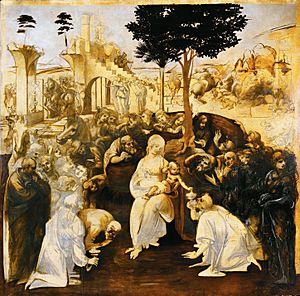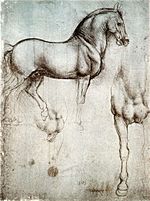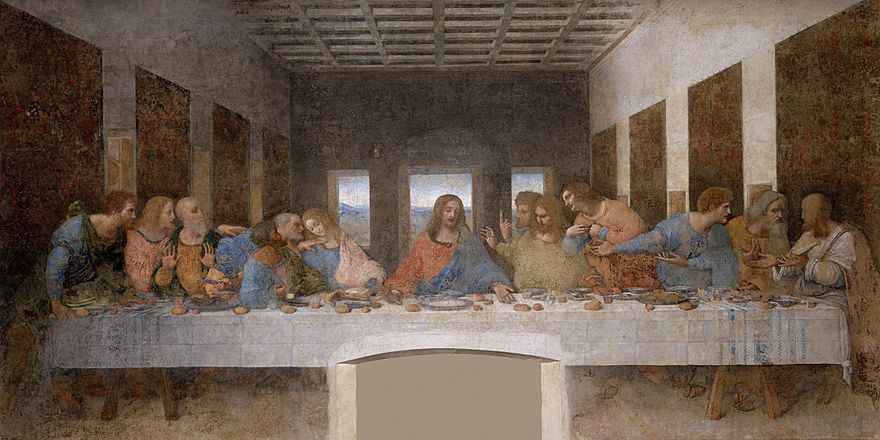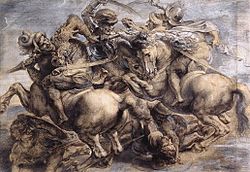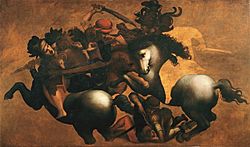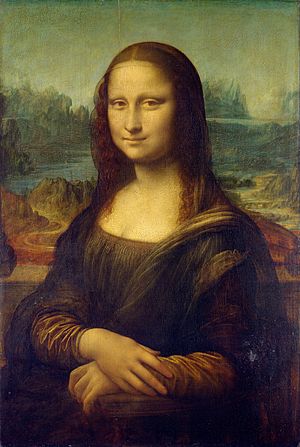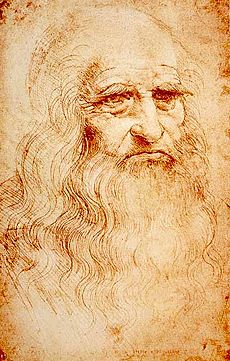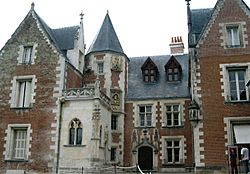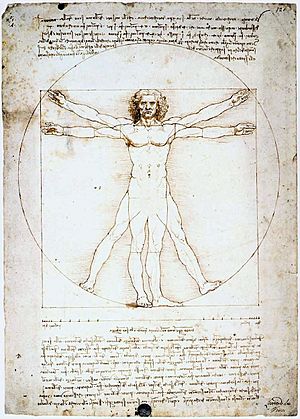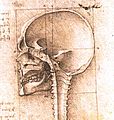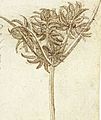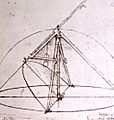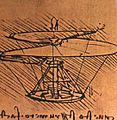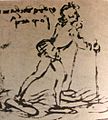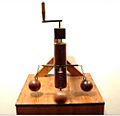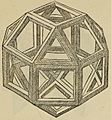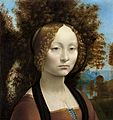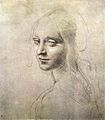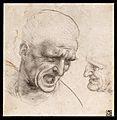Leonardo da Vinci facts for kids
Quick facts for kids
Leonardo da Vinci
|
|
|---|---|
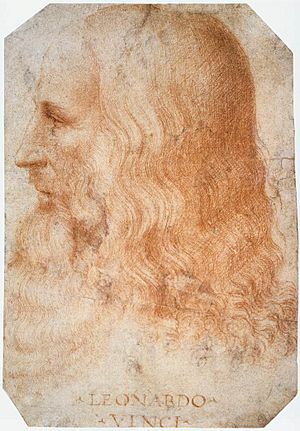
Portrait of Leonardo by Melzi
|
|
| Nationality | Italian |
| Education | Verrocchio |
| Known for | Arts and sciences |
|
Notable work
|
|
| Movement | High Renaissance |
| Patron(s) | King of France |
| Signature | |
Leonardo da Vinci (April 15, 1452 – May 2, 1519) was an Italian man who lived in the time of the Renaissance. He is famous for his paintings, but he was also a scientist, mathematician, engineer, inventor, anatomist, sculptor, architect, botanist, musician, and a writer. Leonardo wanted to know everything about nature. He wanted to know how everything worked. He was very good at studying, designing, and making all sorts of interesting things.
Many people think that Leonardo was one of the greatest painters of all time. Other people think that he was the most talented person ever to have lived.
Leonardo was born at Vinci which is a small town near Florence, Italy. He was trained to be an artist by the sculptor and painter Verrocchio. He spent most of his life working for rich Italian noblemen. In his last years, he lived in a beautiful home given to him by the King of France.
Two of his pictures are among the best-known paintings in the world: the Mona Lisa and The Last Supper. He drew many drawings. The best-known drawing is Vitruvian Man. Leonardo was often thinking of new inventions. He kept notebooks with notes and drawings of these ideas. Most of his inventions were never made. Some of his ideas were a helicopter, a tank, a calculator, a parachute, a robot, a telephone, and solar power.
Contents
Life
Childhood, 1452–1466
Leonardo was born on April 15, 1452, in the Tuscan hill town of Vinci, in the valley of the Arno River. His grandfather, Antonio da Vinci, wrote down the details of his birth. Leonardo's full name was "Leonardo di ser Piero da Vinci," which means "Leonardo, the son of Messer (Mister) Pierdaom Vinci."
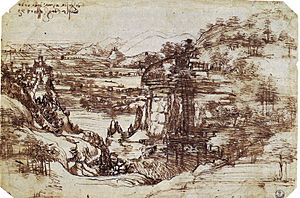
Leonardo spent his first five years living in a farmhouse with his mother, who had not married his father. Then he lived at Vinci with his father, his father's new wife Albiera, his grandparents, and his Uncle Francesco.
Leonardo started painting while he was still a boy. Giorgio Vasari a biographer (a person who tells the story of someone's life), wrote about Leonardo's life shortly after his death. He tells many interesting stories about how clever Leonardo was. He says that Leonardo painted a round wooden shield with a picture of snakes spitting fire. Leonardo's father took his painting to Florence and sold it to an art dealer.
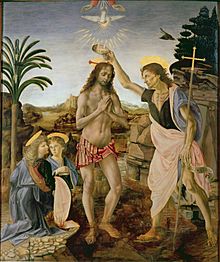
Verrocchio's workshop, 1466–1476
In 1466, when Leonardo was fourteen, his father took him to Florence to be an apprentice to the artist Verrocchio.
Florence was a very exciting place for a young person who wanted to be an artist. Many famous artists had lived in Florence. If an artist were lucky, he would find a rich patron who would buy many of his paintings. The wealthiest family in Florence was the Medici. They had built themselves the finest palace in Florence and liked buying paintings, statues, and other beautiful things. They were also interested in the study of literature and philosophy. Many young artists hoped to get work from the Medici and their friends.
Verrocchio had a big workshop that was one of the busiest in Florence. Leonardo was learning to be an artist, so he had to learn drawing, painting, sculpting, and model making. While he was at the workshop, he was able to learn all sorts of other useful skills: chemistry, metallurgy, metal working, plaster casting, leather working, mechanics, and carpentry.
Leonardo was not the only young painter at Verrocchio's workshop. Many other painters were trained there or often visited. Some of them later became famous: Ghirlandaio, Perugino, and Botticelli. These artists were all just a few years older than Leonardo.
Giorgio Vasari tells an interesting story from this time of Leonardo's life. Verrocchio was painting a large picture of the Baptism of Christ. He gave Leonardo the job of painting one of the angels holding Jesus' robe on the left side of the picture. Vasari said that Leonardo painted the angel so beautifully that Verrocchio put down his brush and never painted again. When the painting is examined closely, it is possible to see that many other parts of the picture, such as the rocks, the brown stream, and the background may have been painted by Leonardo as well. Verrocchio made a bronze statue of David at this time. It is believed that he used Leonardo as his model.
In about 1472, when he was twenty, Leonardo joined the Guild of St. Luke, an organization of artists and doctors of medicine. Even after his father set him up in his own workshop, Leonardo still enjoyed working at Verrocchio's workshop.
Working life, 1476–1499
When Vasari writes about Leonardo, he uses words like "noble," "generous," "graceful," and "beautiful." Vasari tells us that as an adult, Leonardo was a tall handsome man.
Very little is known about Leonardo's life and work between 1472 and 1481. He was probably busy in Florence. In 1478, he had an important commission to paint an altarpiece for the Monks of San Donato a Scopeto. The painting was to be the Adoration of the Magi (The Three Wise Men). The painting was never finished because Lorenzo Medici sent Leonardo to Milan as an ambassador.
Leonardo was a very talented musician. In 1482, he made a silver lyre (a musical instrument) in the shape of a horse's head. At that time, there was a new ruler in the city of Milan, in northern Italy. Duke Ludovico il Moro was making other rulers nervous. Lorenzo de Medici wanted Leonardo to give Ludovico the lyre as a present from him. Leonardo stayed in Milan and worked for the Duke between 1482 and 1499. Part of his work was to design festivals and carnival processions. He did not realize at the time that it was for his painting that he would be most remembered.
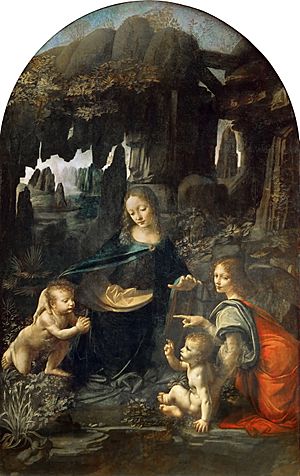
Gran Cavallo
Leonardo's most important work for Duke Ludovico was to make a huge statue of the previous ruler, Francesco Sforza, on horseback. He made a huge horse of clay called the Gran Cavallo. It was going to be cast in bronze. However, the bronze had to be used for making cannons because the French army was invading Milan. The statue was never finished.
The Virgin of the Rocks
While Leonardo was working for Duke Ludovico, he had two important painting commissions. One was to do an oil painting to go in a big altarpiece for the Confraternity of the Immaculate Conception. Leonardo did the painting twice. He left one with the monks in Milan and took the other painting to France where it is now in the Louvre Museum. The paintings are both called the Virgin of the Rocks. They show a scene of the Virgin Mary and the child Jesus in a rocky mysterious landscape. Mary and Jesus are meeting with John the Baptist. There is a story (which is not in the Bible but is part of Christian tradition) about how baby John and baby Jesus met on the road to Egypt. In this scene, John is praying and the baby Jesus raises his hand to bless John. The paintings have a strange light with soft deep shadows. In the background is a lake and mountains in the mist. No painting like this had ever been done before.
The Last Supper
Leonardo's other important painting in Milan is his most famous. It is the Last Supper. The painting shows the last meal shared by Jesus with his disciples, before his capture and death. Leonardo chose to paint the moment when Jesus said "one of you will betray me." Leonardo tells the story of the surprise and upset that this caused to the twelve followers of Jesus. He tells the story through the actions and faces of the people in the painting. Some of them are talking, some of them have stood up, and some are raising their hands in horror. Even though in some places the paint has fallen off the wall, the painting is so popular that it is printed and copied more that any other religious painting in the world.
Working life, 1499–1513
In 1499, Ludovico il Moro was overthrown. Leonardo left Milan with his servant Salai and a friend, Luca Pacioli, who was a mathematician. They went to Venice. Leonardo worked as a military architect and engineer. Because Venice is a city on many islands, Leonardo tried to think of ways to defend the city from a naval attack.
In 1500, Leonardo went back to Florence, taking his "household" of servants and apprentices with him. The monks from the monastery of The Holy Annunciation gave Leonardo a home and a large workshop. In 2005, some buildings which were used by the Department of Military Geography were being restored. The restorers discovered that part of the building was Leonardo's studio.
The Virgin and Child with St. Anne and John the Baptist
Leonardo started work on a new painting in about 1499. He drew a large "cartoon." (This means a drawing that is a plan for the painting.) The cartoon showed the Virgin Mary sitting on the knee of her mother, Saint Anne. Mary holds baby Jesus in her arms. Jesus stretches out his hands to his young cousin John the Baptist. The drawing is now in the National Gallery, London. Even though it is old and faded and is kept in a dark room, people go to the gallery to sit in front of it every day. Like many of Leonardo's projects, the painting was never done.
The Battle of Anghiari
In 1502 and 1503, Leonardo worked for Cesare Borgia, a powerful noble who was the son of Pope Alexander VI. Late in 1503, Leonardo returned to Florence. He rejoined the Guild of St Luke.
He was given a very important commission. The Signoria (Town Council) of the City of Florence wanted two large frescos painted on the walls of the most important room of the Signoria Palace. Michelangelo was to paint The Battle of Cascina and Leonardo was to paint The Battle of Anghiari. Leonardo began the project by studying and drawing the faces of angry men and fighting horses. These drawings can still be seen in his notebooks. Unfortunately, neither painting was finished. Leonardo mixed the paints with oil rather than using fresco, and the paintings would not dry. Michelangelo was called to Rome by the Pope.
Mona Lisa
In about 1503, Leonardo began painting the portrait of a woman known as Mona Lisa, the most famous portrait that has ever been painted. He continued working on it for many years. It is a small picture, painted in oil on a wooden panel. It shows the face, upper body, and hands of a woman. She is very plainly dressed. For a portrait, a woman would usually put on her best clothes and jewelry. Mona Lisa has a dark dress and a fine black veil over her head. Leonardo often left symbols in his paintings that give clues about the person. The unusual thing about this picture is the smile. (Mona is short for Madonna which means "My Lady.")
The reason why the painting is so famous is that it seems to be full of mystery. Mona Lisa's eyes look out at the viewer, but no one can guess what she is thinking. Her eyes and her mouth seem to be smiling. This is very unusual in a portrait painting. Most people in portraits look very serious. It is hard to tell what Mona Lisa's exact expression is. When a person wants to read another person's feelings, they look at the corners of their mouth and eyes. But Leonardo painted soft shadows in the corners of Mona Lisa's mouth and eyes, to disguise her expression. Soft shadows are also found on the sides of her face, her neck, and her hands. The way that Leonardo uses shadow is called "sfumato" (which is an Italian word for "smoke").
Working life, 1506–1516
In 1506, Leonardo went back to Milan with his pupils and lived in his own house in Porta Orientale. Some of his pupils became painters and made several copies of his paintings.
In September 1513, Leonardo went to Rome and lived there until 1516. He lived in the Vatican. The three greatest painters of the High Renaissance, Leonardo, Michelangelo, and Raphael, were all working in Rome at the same time. Even though their names are often said together as if they were friends, they were not. Leonardo at this time was in his sixties, while Michelangelo was middle-aged and was not friendly to either Leonardo or Raphael. Raphael was a very clever young painter who learned by looking at the work of the other two masters, but neither was ever his teacher.
In October 1515, King Francis I of France captured Milan. On December 19, there was a meeting of Francis I and Pope Leo X, in Bologna. Leonardo went to the meeting with Pope Leo, where he brought an amazing toy to entertain King Francis. It was a life-sized mechanical lion that could walk. It had doors in its chest which opened, and a bunch of lilies came out. Lilies were the royal symbol of the French Kings.
Old age, 1516–1519
In 1516, Francis I invited Leonardo to go to France with him. The two men had become close friends. King Francis gave Leonardo a beautiful house called Clos Lucé (sometimes called "Cloux"). It is near the king's palace, Chateau Amboise. Leonardo spent the last three years of his life at Clos Lucé with his faithful friend and apprentice, Count Melzi. One of the last paintings that Leonardo did was a picture of John the Baptist.
When Leonardo was dying, he asked for a priest to come so that he could make his confession and receive Holy Communion. Leonardo died at Clos Lucé on May 2, 1519. In his will, he asked that sixty beggars should follow his casket in procession. He was buried in the Chapel of the Chateau Amboise. In his will, he left his money, his books, and most of his paintings to Count Melzi.
Drawings
Leonardo did not paint very many pictures, but he drew hundreds of quick sketches, plans, maps, and detailed drawings. This is the way that he recorded all the interesting things that he saw, studied, and thought about. Some of Leonardo's drawings are "studies" for paintings. In these drawings, Leonardo planned the things he was going to paint. The earliest drawing by Leonardo is a Landscape of the Arno Valley, which shows the river, the mountains, Montelupo Castle, and the farmlands beyond it in great detail. It is a pen and ink of the Arno River valley and is dated August 5, 1473. It is now in the Uffizi Gallery.
Leonardo's notebooks
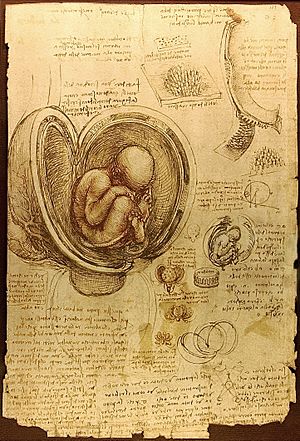
Leonardo studied things all his life. He did not go to college to study. He studied by looking at things in the world around him. He looked at things to see how they were made and how they worked. He drew the things that he saw and the discoveries that he made into his notebooks and made notes about them. Many of his notebooks are now in museums. There are 13,000 pages of notes and drawings. Many of these are scientific studies.
Leonardo's notebooks are hard to read because he wrote backward in "mirror writing." Some people think that perhaps he was trying to keep his work secret. This is not true. Leonardo wrote (and sometimes drew) with his left hand. In those days, pens were made from a quill (a large feather) that was cut with a pen knife on the end. It is hard for a left-handed person to write with a quill in the ordinary way, but quite easy to write backward.
Leonardo probably planned to publish the studies in his notebooks. He organized many pages carefully, with one study taking up the front and back of each page. There is a page with drawings and writing about the human heart and a page about the womb and the fetus. One page shows drawings of the muscles of a shoulder and another page shows how an arm works.
The notebooks were not published in Leonardo's lifetime. After he died, they were divided among different people who had known him. They are nearly all in museums or libraries such as Windsor Castle, the Louvre, and the British Library. The Biblioteca Ambrosiana (a library) in Milan has the twelve-volume Codex Atlanticus.
Studies
Some of the things that Leonardo studied are:
- The geology of the Earth, with its mountains, valleys, rivers, and rocks.
- The anatomy of the human body with its skeleton, muscles, veins, and internal organs. Leonardo was given dead bodies by a hospital. He "dissected" (cut up) thirty dead bodies and carefully drew many of the parts. His drawings of bones and muscles were to help other artists paint the human body properly.
- The anatomy of horses, cows, dogs, and bears.
- The expressions on human faces.
- The flight of birds.
- The weather and its phenomena.
- The way that water flows.
- The botany of plants.
- Light, shadows, mirrors and lenses.
- Perspective and the way to make things look near or far.
- The geometry of solid objects. He drew many careful pictures which were used by the mathematician Luca Pacioli in a book called De Divina Proportione.
Designs and inventions
Many of the drawings and notes in Leonardo's notebooks are designs, plans, and inventions. Some of the things that Leonardo designed are:
- Costumes for parades, carnivals, and theatre. These were probably for Duke Federico's court. They include armor, and a ferocious dragon.
- War machines such as an armor-plated tank, an enormous cross bow, and a horrible horse-driven leg-chopper. None of these things were ever made in Leonardo's lifetime.
- Dams and canals for rivers.
- A wooden bridge that could be carried flat on wagons and unfolded and put together at the river.
- Flying things with wings that flapped, a helicopter, a parachute, and a hang glider. One of Leonardo's servants was injured when he was testing the hang glider. The parachute has been made and tested in modern times, and it does work.
- Churches and castles. It is possible that the Castle of Locarno in southern Switzerland was designed by Leonardo. No other building that he designed was built.
Leonardo's studies, designs, and inventions
Interesting Facts about Leonardo da Vinci
- Because of Leonardo's many varying interests, he would often fail to complete his paintings and projects.
- He loved animals. He spent time studying birds, which helped him invent flight-related projects.
- He also played the lyre and the flute, often performing at gatherings of the nobility and the houses of his patrons.
- His parents never married. He lived with his father and stepmother and had 12 half-siblings.
- Because they were kept secret, many of his scientific discoveries did not help scientific advancement during the Renaissance period.
- Leonardo was one of the first Italians to use oil paint.
- It is thought that a stroke left Leonardo’s right hand paralyzed. This meant that he was unable to complete some of his paintings.
- "da Vinci" means "of Vinci." Last names did not become popular until after Leonardo's death.
- He never married or had children.
Related pages
- Renaissance
- Italian Renaissance art
- Lady with an Ermine
- List of Renaissance artists
- Michelangelo
- Raphael
Images for kids
-
The Virgin and Child with Saint Anne and Saint John the Baptist, c. 1499–1508, National Gallery, London
-
Presumed self-portrait of Leonardo (c. 1510) at the Royal Library of Turin, Italy
-
Rhombicuboctahedron as published in Pacioli's Divina proportione (1509)
-
Statue outside the Uffizi, Florence, by Luigi Pampaloni (1791–1847)
-
The Death of Leonardo da Vinci, by Ingres, 1818
-
Ginevra de' Benci, c. 1474–1480, National Gallery of Art, Washington D.C.
-
Benois Madonna, c. 1478–1481, Hermitage, Saint Petersburg
-
Head of a Woman, c. 1483–1485, Royal Library of Turin
-
Leonardo's map of Imola, created for Cesare Borgia, 1502
See also
 In Spanish: Leonardo da Vinci para niños
In Spanish: Leonardo da Vinci para niños



